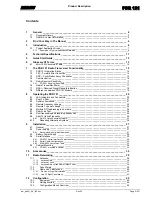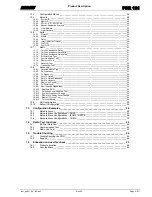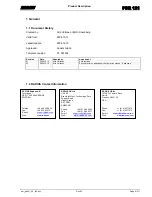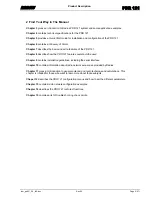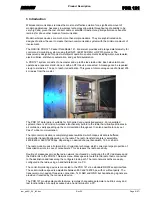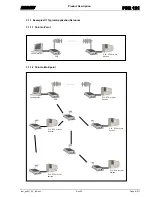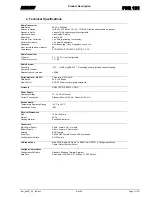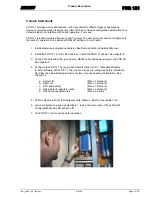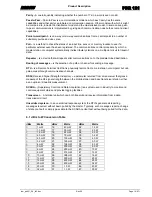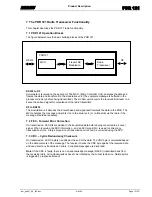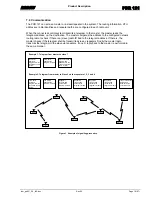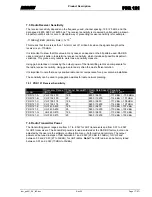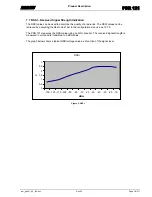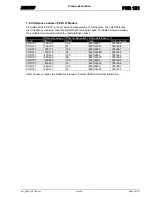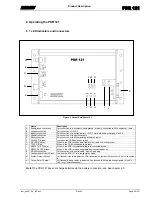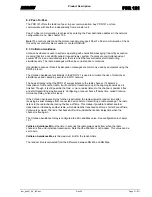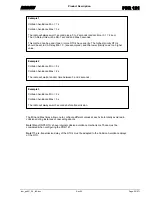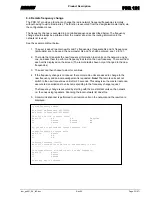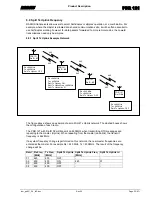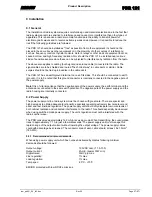
RADIUS
Product
Description
PDR 121
iom_pdr121_04_r02.doc
Rev 02
Page 13 (67)
6 Glossary Of Terms
Some of the terms and abbreviations used in this product description may be unfamiliar if you are
new to digital radio systems. The following glossary explains these terms, which can be helpful in
understanding the operation of the PDR 121.
Bit –
is
the smallest unit of digital data, computational quantity that can take on one of two values,
such as false and true or 0 and 1.
bps –
bits per second. The unit in which data transfer rate is measured across a communication
channel in serial transmissions. 9600 bps indicates that 9600 bits are transmitted in one second.
Byte
– is often eight bits and the smallest addressable unit of storage.
Channel bandwidth
–
in addition to the direction of transmission, a channel is characterized by its
bandwidth. In general, the greater the bandwidth of the assigned channels, the higher the possible
speed of transmission.
Data telemetry
– transmission of the values of measured variables using telecommunication
techniques
Decibel (dB)
– is a unit of measurement of the strength of a signal
.
dBm
– (Decibels below 1 Milliwatt) A measurement of power loss in decibels using 1 milliwatt as
the reference point.
DCE –
Data Communication Equipment. The devices and connections of a communications
network that connect the communication circuit between the data source and destination (the Data
Terminal Equipment or DTE). A modem is the most common kind of DCE.
DTE –
Data Terminal Equipment.
A device which acts as the source and/or destination of data and
which controls the communication channel. DTE includes terminals, computers, protocol
converters, and multiplexers.
Fade Margin –
The
greatest tolerable reduction in average received signal strength that will be
anticipated under most conditions. This measurement provides an allowance for reduced signal
strength due to multi-path, slight antenna movement or changing atmospheric losses. A fade
margin of 10…20 dB is usually sufficient in most systems.
Flow Control –
The collection of techniques used in serial communications to stop the sender from
sending data until the receiver can accept it. This may be either software flow control or hardware
flow control. The receiver typically has a fixed buffer size into which received data is written as
soon as it is received. When the amount of buffered data exceeds a "high water mark", the receiver
will signal to the transmitter to stop transmitting until the process reading the data has read
sufficient data from the buffer that it has reached its "low water mark", at which point the receiver
signals to the transmitter to resume transmission.
FSK Frequency Shift Keying
– The use of frequency modulation to transmit digital data, i.e. two
different modulation frequencies are used to represent zero and one. More than two frequencies
can be used to increase transmission rates.
Master –
is
the unique application entity within the distributed application which directly or indirectly
controls the entire activity for this atomic action.
Multiple RTU addressing
–
several RTU’s share the same radio unit; each RTU has its own
address in the radio unit network list.
Slave –
is
a unit, which is under the control of another unit (
Master
).
Packet switched –
Describing a system whereby messages are broken down into smaller units
called packets, which are then individually addressed and routed through the network.


